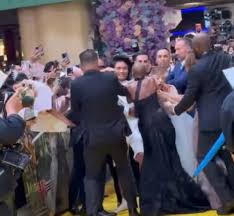The Pyjama Man Incident: When a Stunt Went Too Far at Ariana Grande’s Singapore Premiere
On the evening of November 13, 2025, what was meant to a glamorous yellow carpet premiere for Wicked. For Good at Universal Studios Singapore turned into a shocking and deeply unsettling spectacle. A man charged through the crowd, jumped over the barricades, and wrapped his arm around pop superstar Ariana Grande .
A moment that shook fans, raised critical questions about red-carpet security, and sparked a harsh legal fallout. The man, later identified as Johnson Wen, a 26 year old Australian social media personality. And known online as “Pyjama Man,” has since been deported and banned from re-entering Singapore after serving a jail sentence.
Here’s a comprehensive look at who he is, what happened, why it matters, and what broader lessons the incident carries in our era of social media stunts and celebrity safety.
Who Is Johnson “Pyjama Man” Wen?
Johnson Wen, widely known by his online alias “Pyjama Man,” is no ordinary fan. Over the years, he has drawn attention for repeatedly disrupting high-profile events often as a self described “prankster” or “serial intruder.” Reports indicate he has crashed concerts by prominent artists before, including Katy Perry and The Weekend, and even made appearances at major sporting events.
His online brand seems steeped in the desire for viral moments. He often dresses in eccentric clothing (hence the “pyjama” moniker), films his stunts, and uploads them to his social media. After the incident at the Wicked premiere, he posted a video on his social accounts, captioned: “Dear Ariana Grande Thank You for letting me Jump on the Yellow Carpet with You ❤️.”
To many, his behaviour isn’t just harmless fun . It’s deeply dangerous, crossing the line into harassment and physical violation.
The Singapore Premiere: What Actually Happened
The Setting
The Wicked: For Good premiere was held at Universal Studios Singapore, where Ariana Grande walked her portion of the yellow-brick road style carpet flanked by her co-stars, including Cynthia Erivo, Michelle Yeoh, and Jeff Goldblum.
The Intrusion
But then, in a moment captured by multiple onlookers and quickly disseminated across social media, a man suddenly vaulted over a barricade. He sprinted directly toward Grande.
Who is the man the persona behind the stunt
He has posted numerous videos over time in which he crashes concerts or high-profile moments to get attention, earning him reputations in media reports as a serial intruder. Online he has used the handle associated with “pyjama” attire and has posted footage framing such incursions as achievements or stunts.
When the same person repeatedly attempts similar intrusions, courts and immigration authorities tend to view the act as part of a track record, not an isolated youthful mistake. That context shaped the legal response.
Immediate response security, co stars, and crowd reaction
Witness footage and eyewitness accounts show how quickly the scene escalated and how equally quickly it was contained. Cynthia Erivo Grande’s co-star on the film’s press tour instinctively placed herself between Grande and the intruder; photographers and security personnel moved in to separate the parties. Grande looked visibly shaken afterwards. Other attendees and fans expressed alarm and anger as the clip spread.
Security teams at red-carpet events are trained for many contingencies, but breaches still occur when an individual determines to leap barriers or exploit gaps. The incident triggered renewed questions about how charity galas, premiere events, and concerts balance accessibility (fans want to see stars) with robust physical protection for the talent on the carpet. In this case, a human another celebrity played a critical protective role in the seconds before security could fully intervene.
Legal proceedings and sentencing
Singaporean authorities arrested the man shortly after the event and charged him with the offence commonly prosecuted in such situations: being a public nuisance. He appeared in court, pleaded guilty, and was sentenced to nine days in jail. In handing down the sentence, the judge characterised his behaviour as attention-seeking and warned against the assumption that such actions have no consequences. The prosecution emphasised the defendant’s prior record of similar stunts as aggravating context during sentencing.
From a legal perspective, the offence of public nuisance can carry significantly heavier maximum penalties than the final sentence imposed. That the court opted for nine days reflected both the seriousness with which the court treated the act and contemporary sentencing practices that balance deterrence with proportionality.
Why this case resonated globally
Several factors amplified the global resonance of this incident:
-
The celebrity involved. The footage focused on her vulnerability in a public moment, which struck many viewers as especially disturbing.
- The bystander heroism. The swift intervention by Cynthia Erivo herself an acclaimed performer created a powerful visual narrative of protection and solidarity that many viewers praised. Her response re framed a frightening moment into one where colleagues stepped up.
- The repeat-offender pattern. Reporting that the perpetrator had previously crashed events re framed the act as calculated and repetitive, not a one off mistake, increasing calls for harsher responses.
- The social media calculus. The suspect’s apparent motive to gain online attention highlighted the perverse incentives that viral platforms can create: momentary fame in exchange for dangerous, abusive behaviour. This provoked broader critiques about the culture that rewards such stunts.
- These elements combined to push the story beyond entertainment headlines into a conversation about safety, accountability, and the unintended incentives of the online attention economy.
The legal and ethical debate: punishment, deterrence, and rehabilitation
Some commentators questioned whether a nine-day jail stay is sufficient to deter future wrongdoing, especially given the repeat pattern alleged in reporting. Public nuisance laws typically carry higher maximum sentences; the fact that the court gave a short custodial sentence reflects judicial discretion balancing several factors, including remorse, prior record, and the specifics of the case. Nevertheless, many observers argued that the combination of criminal jail time plus an immigration ban sends a sharper overall message than a short sentence alone might suggest.
Beyond punishment, there’s an argument for rehabilitative intervention. When social-media driven attention becomes a motivating force for repeated public endangerment, some legal experts and clinicians suggest that mental-health evaluation, counselings, or mandated behavioural programs might serve the public interest better in the long run than brief incarceration. The criminal justice response can be one part of a comprehensive approach that also addresses underlying drivers of attention-seeking conduct.
Event safety and the limits of openness
Red-carpet events intentionally strike a balance between spectacle and security. Heightened screening of quasi-access areas, and clearer procedures to control crowds while maintaining a hospitable atmosphere.
The role of platforms and the attention economy
The man’s motive the pursuit of viral engagement underscores a larger systemic issue: social platforms reward attention, often without reflecting on the cost. When physical violations yield clicks, likes, and notoriety, the incentives are misaligned. Platforms, advertisers, and even viewers share responsibility for the ecosystem that makes a stunt like this tempting.
Practical responses could include platform-level restrictions on content that depicts non-consensual physical acts in a celebratory light, clearer moderation and removal policies, and cooperation with law enforcement when videos depict criminality. But platforms balancing free expression and safety is complex; technological and policy tools are still evolving to address these kinds of harms.
Audience responsibility: when fans must act like citizens
Fans, too, have a role. An event-goer who sees someone preparing to vault a barricade can and should alert stewards or organisers rather than waiting for a viral moment. Audiences are not passive observers; community members who prioritise safety over a stunt can help prevent escalation. The online and offline communities that celebrate stars also bear responsibility for preserving their safety and dignity.
Ariana Grande, trauma, and context
For many spectators, the moment resonated on an additional level because Ariana Grande is a survivor of a major attack at a previous concert venue some years ago. That prior trauma well documented in public reporting about her life and activism made the current incident feel more alarming and personal to observers, who feared retraumatization and renewed insecurity for the performer. This context informed much of the public sympathy and outrage.
What this ruling signals to would-be intruders and event planners
The combined criminal and immigration outcomes jail time plus deportation and a re entry ban send a layered message:
-
Criminal consequences are real. Courts will impose custodial sentences for deliberate breaches that cross into physical contact and public nuisance.
-
Administrative immigration consequences amplify deterrence.
-
Event security must adapt. Organisers should treat this as a red-flag case prompting reassessment of risk and mitigation strategies.
Together, these measures reflect society’s stance that public stunts causing fear or physical contact are not harmless theatre but actions with real victims and substantial repercussions.
Broader cultural takeaways
This episode is a microcosm of several larger trends:
-
The gap between spectacle and safety public events must reconcile openness with robust protection.
-
The complexity of accountability criminal law, immigration policy, platform governance, and social norms must all interact to deter wrongdoing.
-
The need for empathy and responsibility fans and viewers can encourage safer, more respectful forms of celebrity engagement.
If anything, the incident should prompt not only regulatory or procedural changes but also a deeper conversation in online cultures about what kinds of behaviour we reward and why.
Final thoughts
What began as a moment of selfish, attention-seeking behaviour ended with legal consequences and an official ban. The man’s deportation and re entry bar are administrative responses that, combined with his criminal conviction, restrict, His ability to repeat such stunts on Singaporean soil. For Ariana Grande and other public figures. Who must make their way through crowds for publicity and appearance, the event is a blunt reminder. Fame invites attention, and sometimes that attention can be threatening.
The path forward requires multiple actors event organizers, law enforcement, immigration authorities, social platforms, fans. And celebrities to align where safety, dignity, and the rule of law are concerned. Viral fame should not be a pass to violate others. This incident should remembered not as a quirky internet episode. But as a teachable moment about boundaries, accountability. The real human costs when the chase for short lived notoriety crosses into harm.
Related Article:
A Comprehensive Overview On US Support Programs
Former Fox News Host Jeanine Pirro as US Attorney for DC












